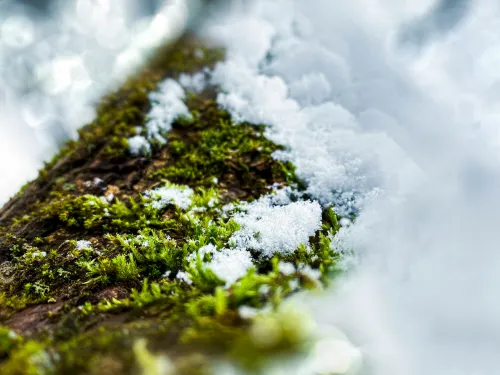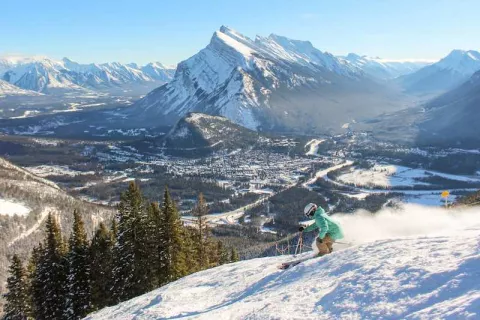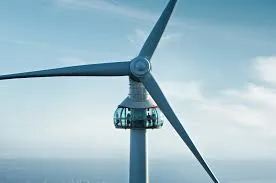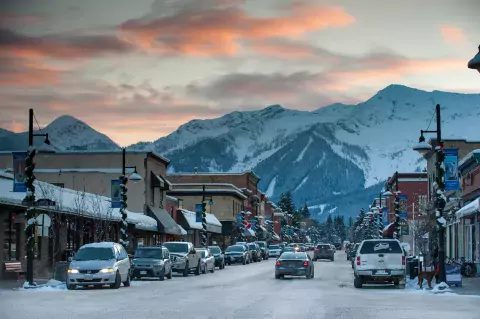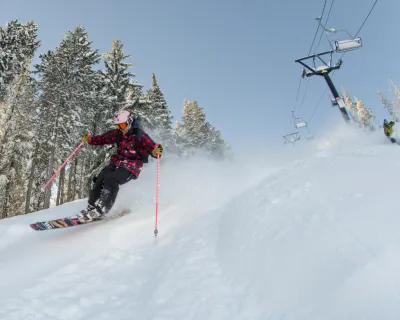
Could Western Canada ski resorts go 100% green?
Running ski lifts, heating lodges, fueling snow cats, operating restaurants—resorts consume a fair bit of energy and it has to come from somewhere.
But climate change is also coming for our sport, and after all, the winter resort industry is a business and in the face of a warming climate, shorter seasons and higher temperatures have a direct impact on their bottom line.
So when Mount Norquay, Banff's oldest ski resort, announced its plans to power the resort on 100% green energy, it caught our interest.
We wondered, how close could the ski industry get to 100% green? What are ski resorts in Alberta and BC doing to manage their environmental footprint in 2025-26?
We dove into it, and we were excited to see that there has been some impressive progress in the industry right here in Western Canada.
How ski resorts are shrinking their environmental impact
From green-powered lifts, to habitat restoration and water efficiency initiatives, the ski industry is embracing innovation to shrink its environmental footprint.
These efforts are more than just good stewardship, they’re a commitment to ensure that future generations can continue to experience the magic of winter.
Mount Norquay 100
Mount Norquay, one of Banff's Big 3 resorts, just might be leading the charge of sustainability. Norquay is its centennial season in 2025-26, under the banner of sustainability and forward-thinking innovation.
As part of its Norquay 100 Vision, the resort has committed to being 100% powered by green energy, sourcing all electricity for lifts, lodges, snowmaking, and staff housing through renewable wind and low-impact hydro projects in partnership with Bullfrog Power.
Beyond energy, Norquay's centenary plan includes:
- replacing aging infrastructure with a modern gondola system
- protecting sensitive alpine habitat
- enhancing accessibility (including a wheelchair-friendly Via Ferrata)
- reducing its built footprint
- and eliminating single-use plastics.
Sustainability isn't something new at Norquay either. Since 2015 the resort has cut 1,500 tonnes of CO2, which is equivalent to 350 gasoline-powered vehicles being driven for one year. The aim is to honour a century of winter tradition while ensuring that the next 100 years are greener, more inclusive, and more respectful of the mountain's ecosystem.
Sunshine Village snow and water consumption
Banff Sunshine, another Ski Big 3 resort in Banff National Park, ensures ecological integrity is a top priority, and not just because it is located within Canada's first national park.
Snow farming
Artificial snow making is an energy intensive process that requires large volumes of water to be effective. With one of the most extensive snow-farming programs in North America, Sunshine has eliminated snow making on its resort.
Water reduction
But snow farming isn't the only way the resort is saving water though. The resort has implemented a range of water-reducing measures (e.g. dual-flush toilets, low-flow showerheads and metered faucets in public washrooms throughout their on-mountain facilities).
Stormwater management
During recent base parking upgrades, Sunshine also retrofit the lot with an environmentally-friendly stormwater management system.
Instead of polluted vehicle runoff simply entering Healy Creek it now gets filtered through underground oil/grit separators (OGSs) before entering local waterways.
More eco-initiatives at Western Canada ski resorts
There are a host of other environmental initiatives being employed by winter resorts across Western Canada, all in the name of sustainability and protecting the surrounding environment.
Grouse Mountain has The Eye of the Wind turbine, which supplies approximately one-quarter of the resort's operational electricity needs.
Whistler Blackcomb is involved with the Fitzsimmons Creek Hydro Project, which produces enough power to operate lifts, snow-making infrastructure, and restaurants throughout the winter and summer months.
Big White launched the Community Energy Conservation Engagement project in collaboration with FortisBC and GreenStep Solutions with the goal of identifying energy conservation measures, programs, policies, and initiatives.
Rabbit Hill Ski Area in Edmonton implemented an upcycling project in collaboration with Blenderz Garment Recyclers where old staff uniforms are recycled into usable accessories (headbands and duffel bags for example), giving old memories a new purpose while reducing textile waste.
Cypress Mountain is in the midst of their ForeverProject, the resort's sustainability initiative with a goal of reaching net-zero emissions by 2030.
Panorama Resort, on the ecology side of the equation, has the distinction of being the first resort in Canada to be certified as a Whitebark Pine Friendly Ski Area due to the outreach and educational programming they run to support this endangered keystone species. They also collect cones and replant these threatened trees in an effort to boost their numbers.
Lake Louise Ski Resort has a dedicated full-time, year-round environmental team that manage and maintain the resort's sustainability efforts. Much of their time is focused on wildlife, especially Grizzly Bears, and the resort goes to great lengths to provide and protect on-mountain habitats and wildlife corridors.
Reducing transportation emissions across the industry
One of the largest sources of pollution in the world of winter sports isn't even linked to on-hill operations, it is private vehicles delivering visitors to the mountain.
One study reported that over half the carbon footprint of a ski trip is linked to transportation.
While not always easy to combat, especially with many resorts in remote locations, many operations are partnering with public transportation to help reduce emissions.
- Banff region: ROAM public transit, hotel-to-resort shuttles, the Lake Louise Ski Bus, and the Ten Peaks Direct Shuttle
- Kimberley has the Peak to Platzl shuttle
- Big White and Silverstar rely on the Kelowna Ski Shuttle, Mountain Snow Transport, and Kelowna Concierge
- Jasper has three shuttle bus operators: SunDog, Magic Bus and Backside Tours shuttles.
- Whistler Blackcomb has the well-established Whistler Transit
- Mount Revelstoke can be accessed via the Resort Shuttle and Revelstoke Transit
- Mount Washington has the Ski & Ride Shuttle Bus.
- Other resorts, such as Grouse Mountain and Hart Ski Hill are connected via the community's public transit system.
Taking transit doesn't only reduce your own carbon footprint but it also eliminates the need to find that ever-elusive parking spot, ensuring you can hop on that chairlift even sooner.
NSAA support for eco-initiatives
It's worth mentioning that resorts aren't going at it alone either. The National Ski Areas Association (NSAA) has established sustainability guidelines, known as Sustainable Slopes.
score better snow days with SnowSeekers
sign up for the FREE newsletter that gets you into the snow
At its core, it involves an Environmental Charter that has a set of guiding principles to help resorts reduce their environmental footprint, improve stewardship, and engage in best practices in areas such as water, habitat, design and construction, waste, and ecosystem management.
Protect Our Winters (POW) Canada has also created the Resort Alliance, which is essentially a coalition of resort operators from across the country who have committed to taking action against climate change because they realize their businesses, and the future of skiing and snowboarding, depends on taking bold action.
Cypress Mountain, Big White, and RED Mountain have already joined the Resort Alliance program with Cypress reporting a 19% reduction in emissions so far.
Bottom line: can ski resorts be truly eco-friendly?
As winter resorts continue to grow and modernize, they are proving that thrilling alpine experiences and environmental responsibility can go hand in hand.
From renewable energy projects and water efficiency programs to habitat restoration and public transit partnerships, these initiatives demonstrate a commitment to reducing the industry's environmental footprint while preserving the mountains for future generations.
By embracing innovation and sustainability, resorts are not only protecting fragile ecosystems but also inspiring visitors and communities to think more consciously about their impact on the natural world.
In the end, the message is clear: the mountains will continue to be a playground for adventure, but one that is cared for, respected, and sustained.
Ski resorts go eco around the world
What can we learn from elsewhere, when it comes to managing ski resort environmental impacts? Here are some leading initiatives we're seeing, looking outside North America.
US big four collab on climate
The operator of Big Sky in Montana (Boyne Resorts) has entered into a collaborative climate charter with the rest of the big four resort owners in North America (Alterra Mountain Company, Vail Resorts, and POWDR) to move to renewable energy, reduce waste, and engage in climate advocacy. Big Sky has also set a target to be carbon-neutral by 2023.
European leaders
- LAAX, the Swiss freeride mecca, is a leader in alpine sustainability featuring carbon-neutral lifts, hybrid groomers, and vertical gardens to boost biodiversity.
- Golm Montafon holds the claim of being Austria's first climate-neutral winter resort, utilizing solar-powered chairlifts, wildlife-friendly zones, and consistent significant CO2 cuts over the past 10 years.
- Arosa Lenzerheide, another resort Switzerland-based, has a bold strategy (called Arosa 2030) that prioritizes biodiversity, emphasizes significant CO2 reductions, and implements circular resource uses. Their Valsana Hotel also runs on geothermal energy and is pioneering an ice battery system, which effectively eliminates fossil fuels entirely.
Japanese technology
Furano, in Japan, installed bio-toilets and is leveraging technology, such as GPS-aided snow plowing, for more efficient operations and reductions in fuel consumption.
Be part of the snow-lution
Embracing winter and the environment go hand in hand with skiing and snowboarding. Let SnowSeekers guide you to "greener" slopes and deeper pow.
